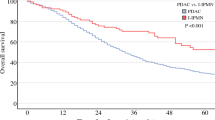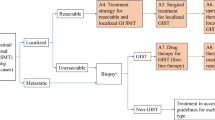Abstract
Purpose
The 2017 revised World Health Organization classification of pancreatic neuroendocrine neoplasms classified conventional G3 tumors into well-differentiated (NET-G3) and poorly differentiated (NEC-G3) tumors. However, guidelines for selection of drug therapy were not established in the 2017 revision. This study aimed to elucidate the rates of maximum tumor reduction of sunitinib, progression-free survival, and overall survival in the new classification.
Methods
We investigated the reduction rate over time using computed tomography for 60 patients with unresectable or distant metastatic pancreatic neuroendocrine neoplasms who received 37.5 mg of sunitinib in our department from April 2013 to November 2017.
Results
Of the 60 cases, 42, 10, and 5 were NET-G1/G2, NET-G3, and NEC-G3, respectively. The prognostic factors were analyzed according to clinicopathological factors using the Cox hazard model. The median observation period was 19 months, and the median duration of sunitinib administration was 7 months. The median maximum reduction rate of sunitinib was 18.3%. Tumor response was classified according to the Response Evaluation Criteria in Solid Tumors: 20 cases (33.3%) showed partial response, 29 cases (48.3%) showed stable disease, and 11 cases (18.3%) showed progressive disease. In a multivariate analysis of factors contributing to progression-free survival from the start of sunitinib administration, only histologically poor differentiation was a significant factor (p = 0.010). Progression-free survival and overall survival were significantly better in patients with NET-G3 than that in patients with NEC-G3 (p = 0.005, p = 0.012), while it was not different between those with NET-G3 and those with NET-G1/2.
Conclusion
Our results indicate that sunitinib is as effective for NET-G3 as for NET-G1/2.



Similar content being viewed by others
References
Abrams TJ, Lee LB, Murray LJ, Pryer NK, Cherrington JM (2003) SU11248 inhibits KIT and platelet-derived growth factor receptor beta in preclinical models of human small cell lung cancer. Mol Cancer Ther 2:471–478
Casanovas O, Hicklin DJ, Bergers G, Hanahan D (2005) Drug resistance by evasion of antiangiogenic targeting of VEGF signaling in late-stage pancreatic islet tumors. Cancer Cell 8:299–309
Fjallskog ML, Lejonklou MH, Oberg KE, Eriksson BK, Janson ET (2003) Expression of molecular targets for tyrosine kinase receptor antagonists in malignant endocrine pancreatic tumors. Clin Cancer Res 9:1469–1473
Hijioka S, Hosoda W, Mizuno N, Hara K, Imaoka H, Bhatia V, Mekky MA, Tajika M, Tanaka T, Ishihara M et al (2015) Does the WHO 2010 classification of pancreatic neuroendocrine neoplasms accurately characterize pancreatic neuroendocrine carcinomas? J Gastroenterol 50(5):564–572
Hijioka S, Hosoda W, Matsuo K, Ueno M, Furukawa M, Yoshitomi H, Kobayashi N, Ikeda M, Ito T, Nakamori S et al (2017) Rb loss and KRAS mutation are predictors of the response to platinum-based chemotherapy in pancreatic neuroendocrine neoplasm with grade 3: a Japanese multicenter pancreatic NEN-G3 study. Clin Cancer Res 23:4625–4632
Ito T, Okusaka T, Nishida T, Yamao K, Igarashi H, Morizane C, Kondo S, Mizuno N, Hara K, Sawaki A et al (2013) Phase II study of sunitinib in Japanese patients with unresectable or metastatic, well-differentiated pancreatic neuroendocrine tumor. Invest New Drugs 31:1265–1274
Ito T, Igarashi H, Nakamura K, Sasano H, Okusaka T, Takano K, Komoto I, Tanaka M, Imamura M, Jensen RT et al (2015) Epidemiological trends of pancreatic and gastrointestinal neuroendocrine tumors in Japan: a nationwide survey analysis. J Gastroenterol 50:58–64
Iwasa S, Morizane C, Okusaka T, Ueno H, Ikeda M, Kondo S, Tanaka T, Nakachi K, Mitsunaga S, Kojima Y et al (2010) Cisplatin and etoposide as first-line chemotherapy for poorly differentiated neuroendocrine carcinoma of the hepatobiliary tract and pancreas. Jpn J Clin Oncol 40:313–318
Konukiewitz B, Schlitter AM, Jesinghaus M, Pfister D, Steiger K, Segler A, Agaimy A, Sipos B, Zamboni G, Weichert W et al (2017) Somatostatin receptor expression related to TP53 and RB1 alterations in pancreatic and extrapancreatic neuroendocrine neoplasms with a Ki67-index above 20. Mod Pathol 30:587–598
Lee L, Ito T, Igarashi H, Miki M, Fujimori N, Kawabe K, Jensen RT, Ogawa Y (2018) Dose and schedule modification are required for long-term continuation of sunitinib in Japanese patients with advanced pancreatic neuroendocrine tumors. Cancer Chemother Pharmacol 81:163–169
Lloyd RV, Osamura RY, Kloppel G, Rosai J (2017) WHO classification of tumours of endocrine organs, WHO/IARC classification of tumours, 4th edn, vol 10. International Agent for Research on Cancer, World Health Organization, lyon
Mani MA, Shroff RT, Jacobs C, Wolff RA, Ajani JA, Yao JC, Phan AT (2008) A phase II study of irinotecan and cisplatin for metastatic or unresectable high grade neuroendocrine carcinoma. J Clin Oncol 26:15550–15550
Mendel DB, Laird AD, Xin X, Louie SG, Christensen JG, Li G, Schreck RE, Abrams TJ, Ngai TJ, Lee LB et al (2003) In vivo antitumor activity of SU11248, a novel tyrosine kinase inhibitor targeting vascular endothelial growth factor and platelet-derived growth factor receptors: determination of a pharmacokinetic/pharmacodynamic relationship. Clin Cancer Res 9:327–337
Murray LJ, Abrams TJ, Long KR, Ngai TJ, Olson LM, Hong W, Keast PK, Brassard JA, O’Farrell AM, Cherrington JM et al (2003) SU11248 inhibits tumor growth and CSF-1R-dependent osteolysis in an experimental breast cancer bone metastasis model. Clin Exp Metastasis 20:757–766
Pape UF, Bohmig M, Berndt U, Tiling N, Wiedenmann B, Plockinger U (2004) Survival and clinical outcome of patients with neuroendocrine tumors of the gastroenteropancreatic tract in a german referral center. Ann N Y Acad Sci 1014:222–233
Pavel M, O’Toole D, Costa F, Capdevila J, Gross D, Kianmanesh R, Krenning E, Knigge U, Salazar R, Pape UF et al (2016) ENETS consensus guidelines update for the management of distant metastatic disease of intestinal, pancreatic, bronchial neuroendocrine neoplasms (NEN) and NEN of unknown primary site. Neuroendocrinology 103:172–185
Raj N, Valentino E, Capanu M, Tang LH, Basturk O, Untch BR, Allen PJ, Klimstra DS, Reidy-Lagunes D (2017) Treatment response and outcomes of grade 3 pancreatic neuroendocrine neoplasms based on morphology: well differentiated versus poorly differentiated. Pancreas 46:296–301
Raymond E, Dahan L, Raoul JL, Bang YJ, Borbath I, Lombard-Bohas C, Valle J, Metrakos P, Smith D, Vinik A et al (2011) Sunitinib malate for the treatment of pancreatic neuroendocrine tumors. N Engl J Med 364:501–513
Rinke A, Muller HH, Schade-Brittinger C, Klose KJ, Barth P, Wied M, Mayer C, Aminossadati B, Pape UF, Blaker M et al (2009) Placebo-controlled, double-blind, prospective, randomized study on the effect of octreotide LAR in the control of tumor growth in patients with metastatic neuroendocrine midgut tumors: a report from the PROMID Study Group. J Clin Oncol 27:4656–4663
Sorbye H, Welin S, Langer SW, Vestermark LW, Holt N, Osterlund P, Dueland S, Hofsli E, Guren MG, Ohrling K et al (2013) Predictive and prognostic factors for treatment and survival in 305 patients with advanced gastrointestinal neuroendocrine carcinoma (WHO G3): the NORDIC NEC study. Ann Oncol 24(1):152–160
Velayoudom-Cephise FL, Duvillard P, Foucan L, Hadoux J, Chougnet CN, Leboulleux S, Malka D, Guigay J, Goere D, Debaere T et al (2013) Are G3 ENETS neuroendocrine neoplasms heterogeneous? Endocr Relat Cancer 20(5):649–657
Yachida S, Vakiani E, White CM, Zhong Y, Saunders T, Morgan R, de Wilde RF, Maitra A, Hicks J, Demarzo AM et al (2012) Small cell and large cell neuroendocrine carcinomas of the pancreas are genetically similar and distinct from well-differentiated pancreatic neuroendocrine tumors. Am J Surg Pathol 36:173–184
Yamaguchi T, Machida N, Morizane C, Kasuga A, Takahashi H, Sudo K, Nishina T, Tobimatsu K, Ishido K, Furuse J et al (2014) Multicenter retrospective analysis of systemic chemotherapy for advanced neuroendocrine carcinoma of the digestive system. Cancer Sci 105:1176–1181
Yao JC, Hassan M, Phan A, Dagohoy C, Leary C, Mares JE, Abdalla EK, Fleming JB, Vauthey JN, Rashid A et al (2008) One hundred years after “carcinoid”: epidemiology of and prognostic factors for neuroendocrine tumors in 35,825 cases in the United States. J Clin Oncol 26:3063–3072
Yao JC, Pavel M, Lombard-Bohas C, Van Cutsem E, Voi M, Brandt U, He W, Chen D, Capdevila J, de Vries EGE et al (2016) Everolimus for the treatment of advanced pancreatic neuroendocrine tumors: overall survival and circulating biomarkers from the randomized, phase III RADIANT-3 study. J Clin Oncol 34:3906–3913
Acknowledgements
This work was supported by Grant-in-Aid for Scientific Research (C) Grant Number 15K10046.
Funding
This work was supported by Grant-in-Aid for Scientific Research (C) Grant number 15K10046.
Author information
Authors and Affiliations
Corresponding author
Ethics declarations
Conflict of interest
The author Yuki Mizuno declares that he has no conflict of interest. The author Atsushi Kudo declares that he has no conflict of interest. The author Takumi Akashi declares that he has no conflict of interest. The author Keiichi Akahoshi declares that he has no conflict of interest. The author Toshiro Ogura declares that he has no conflict of interest. The author Kosuke Ogawa declares that he has no conflict of interest. The author Hiroaki Ono declares that he has no conflict of interest. The author Yusuke Mitsunori declares that he has no conflict of interest. The author Daisuke Ban declares that he has no conflict of interest. The author Shinji Tanaka declares that he has no conflict of interest. The author Ukihide Tateishi declares that he has no conflict of interest. The author Minoru Tanabe declares that he has no conflict of interest.
Ethical approval
All procedures performed in studies involving human participants were in accordance with the ethical standards of the institutional and/or national research committee and with the 1964 Helsinki declaration and its later amendments or comparable ethical standards. The procedures were approved by the Human Research Ethics Committee of Tokyo Medical and Dental University (Approval ID: 1080). This article does not contain any studies with animals performed by any of the authors.
Informed consent
Informed consent was obtained from all individual participants included in the study.
Electronic supplementary material
Below is the link to the electronic supplementary material.
Rights and permissions
About this article
Cite this article
Mizuno, Y., Kudo, A., Akashi, T. et al. Sunitinib shrinks NET-G3 pancreatic neuroendocrine neoplasms. J Cancer Res Clin Oncol 144, 1155–1163 (2018). https://doi.org/10.1007/s00432-018-2636-2
Received:
Accepted:
Published:
Issue Date:
DOI: https://doi.org/10.1007/s00432-018-2636-2




